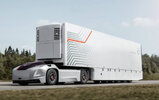- Joined
- 3 July 2009
- Posts
- 28,236
- Reactions
- 25,495
This article gives a perfect example, of how it all boils back to energy density, of the fuel supplying the grunt.
One thing that’s yet to happen in the EV world, however, is figuring out a way to outmatch gas or diesel trucks when it comes to hauling big loads. The video embedded at the top of this page, shot and published by our friends at The Fast Lane Truck on YouTube, is proof that things can be improved on this front.
The two vehicles that were put to the test were the highly controversial Tesla Cybertruck in all-wheel drive Foundation Series trim and the Ram 2500 powered by a Cummins diesel engine.
Both trucks were towing identical ATC PLA 700 trailers. Each is 28 feet long and weighs about 8,000 lbs while the tongue weight is approximately 1,100 lbs.
After setting off for the test, the Cybertruck had an estimated range of 318 miles with a full battery. However, things started to go south pretty quickly. First, the driver said that with cruise control set to 70 miles per hour, he felt the trailer was pushing the truck around a bit and that he didn’t feel too comfortable.
The biggest problem with Tesla’s electric pickup, though, is that it didn’t adjust the estimated range to take the massive energy consumption into account. The state of charge indicator was going down normally and the estimated SoC at the Supercharger that was put into the navigation system was close to reality, but the number of remaining miles was too optimistic, even as the test was reaching the end.
After 85 miles of towing, the Cybertruck was showing just 6% SoC left after munching through 107 kWh of energy. That means an average energy consumption of 1,252 Wh/mile or 0.8 miles/kWh.
The EV was hooked up to a Tesla Supercharger at a Buc-ee's, while the Ram pulled into a gas station to fill up with diesel.
At the end of it all, the Ram needed 8.7 gallons of diesel for almost $26. It averaged about 9.7 mpg.
Tesla Cybertruck AWD vs. Ram 2500 Cummins energy and fuel consumption figures (Source: The Fast Lane Truck)
Meanwhile, the Cybertruck needed 107 kWh of energy to get to 100% for $0.35/kWh at that particular Supercharger. That means “filling up” the EV the same way as the diesel truck would cost $37.45 and it would take over an hour, according to the car’s screen
The two trucks were towing identical 8,000 trailers. One of them went less than 100 miles before needing a top-up.
Electric vehicles have evolved massively over the last two decades. They’re nearly silent in operation, offer great comfort, require low maintenance and more than often cost much less to drive compared to an equivalent combustion vehicle–especially when charging at home overnight.One thing that’s yet to happen in the EV world, however, is figuring out a way to outmatch gas or diesel trucks when it comes to hauling big loads. The video embedded at the top of this page, shot and published by our friends at The Fast Lane Truck on YouTube, is proof that things can be improved on this front.
The two vehicles that were put to the test were the highly controversial Tesla Cybertruck in all-wheel drive Foundation Series trim and the Ram 2500 powered by a Cummins diesel engine.
Both trucks were towing identical ATC PLA 700 trailers. Each is 28 feet long and weighs about 8,000 lbs while the tongue weight is approximately 1,100 lbs.
After setting off for the test, the Cybertruck had an estimated range of 318 miles with a full battery. However, things started to go south pretty quickly. First, the driver said that with cruise control set to 70 miles per hour, he felt the trailer was pushing the truck around a bit and that he didn’t feel too comfortable.
The biggest problem with Tesla’s electric pickup, though, is that it didn’t adjust the estimated range to take the massive energy consumption into account. The state of charge indicator was going down normally and the estimated SoC at the Supercharger that was put into the navigation system was close to reality, but the number of remaining miles was too optimistic, even as the test was reaching the end.
After 85 miles of towing, the Cybertruck was showing just 6% SoC left after munching through 107 kWh of energy. That means an average energy consumption of 1,252 Wh/mile or 0.8 miles/kWh.
The EV was hooked up to a Tesla Supercharger at a Buc-ee's, while the Ram pulled into a gas station to fill up with diesel.
At the end of it all, the Ram needed 8.7 gallons of diesel for almost $26. It averaged about 9.7 mpg.
Tesla Cybertruck AWD vs. Ram 2500 Cummins energy and fuel consumption figures (Source: The Fast Lane Truck)
Meanwhile, the Cybertruck needed 107 kWh of energy to get to 100% for $0.35/kWh at that particular Supercharger. That means “filling up” the EV the same way as the diesel truck would cost $37.45 and it would take over an hour, according to the car’s screen

